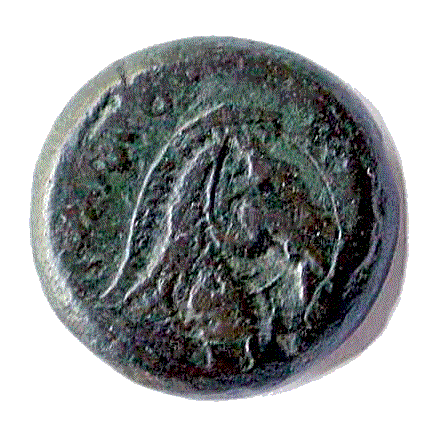The earliest form of Roman 'money' started out as crude lumps of bronze, known as aes rude (crude and unmarked lumps of metal). Also in use at the time were oblong bronze castings known as aes signatum. These signed bronzes bore the stamps of the issuing authority and were used as bullion for barter. Early Roman coinage or pre-denarius coins appeared around 300 BC when interaction between Rome and her neighbouring Greek communities increased - this in turn sparked a growing Roman economic activity. In Magna Graecia, for instance, bronze double litrae, litrae and silver didrachms were issued according to Greek standard. Silver didrachms were eventually replaced by silver quadrigati. In Campania Latin inscriptions superseded both Oscan and Greek inscriptions. Roman coins only differed from Greek coins in the display of the Latin legend ROMANO or ROMA - didrachms with the head of the Roman god of war, Mars, on the obverse, and head of a horse with a corn-ear behind, on the reverse, appeared from 280 - 276 BC in the Campanian region. From c. 269 BC on bronze issues bearing the legend ROMANO depicted the head of Minerva on the obverse, with as reverse type the head of a bridled horse. These types were minted in conjunction with the coinage of the Latin colony of Cosa north of Rome and were similar in design. |
| AE half-litra, anonymous, Romano-Campanian, c. 269 BC |
| |
 |
 |
|
Obv. (left), Head of Minerva (not clear in this specimen), to the left, wearing a crested Corinthian helmet. Rev. Horse's head, bridled, right. The legend ROMANO, is just visible. This design as reverse type recalls the coinage of Tarentum, which in turn imitated Carthaginian coin designs. |
| AE quartuncia, anonymous, Romano-Campanian, c. 269 BC |
 |
 |
 |
 |
Obv. Helmeted head of Minerva right, ROMANO before. Rev. Horse's head right, ROMANO behind. The horse was originally associated with war - a horse was also sacrificed to Mars on the festival of the October equus. |
| Triens c. 215 - 212 BC |
| |
|
Aes grave or cast 'heavy bronze' were crude circular coins - the earliest coinage of central Italy and were issued c. 289 BC. During the Punic wars the aes grave series was modified and the weight reduced. By c. 211 BC struck bronze coins had replaced cast bronze. Denominations were based on a unit or an as = a Roman pound (libra) = 12 unciae, and distinguished by the depiction of spesific types. Relative values were usually displayed on both sides: for instance, an as (12 unciae) displayed the head of Janus and mark of value I; a semis (6 unciae) the head of Saturn and mark of value S. The head of Minerva adorned the obverse of the triens with four pellets (4 unciae) as mark of value and a prow as reverse type. The prow is usually depicted with a club on the forecastle and waves on the keel, sometimes a wing adorns the beak. The uncia showed the head of Bellona and one pellet.Obv. Head of Minerva right, with long hair, wearing a crested Corinthian helmet; an earring of single drop; and a necklace. There are four pellets above Minerva's head. |
By 211 BC the silver denarius replaced the silver quadrigatus. The denarius was lighter in weight and was tariffed at 10 asses. Two other silver denominations - the victoriatus and quinarius were issued concurrently with early denarii. |
| |
Republican | Imperatorial | Imperial | Greek Imperial | Byzantine |